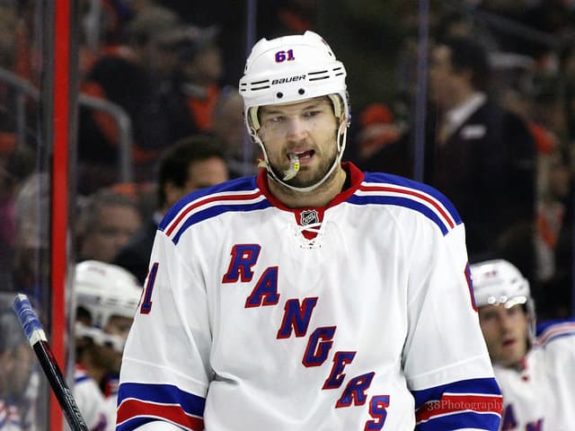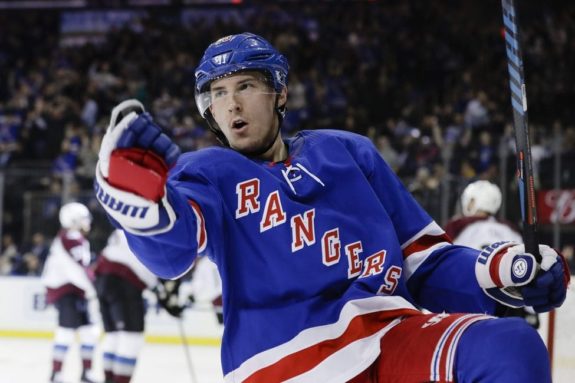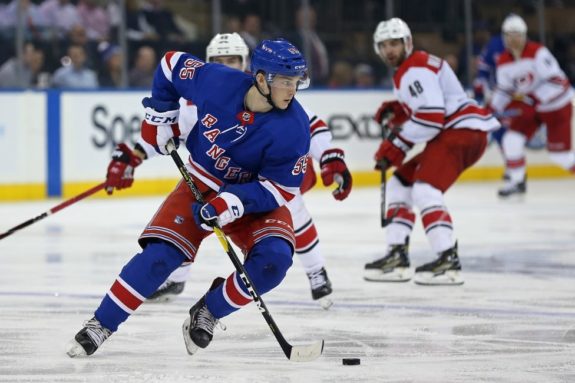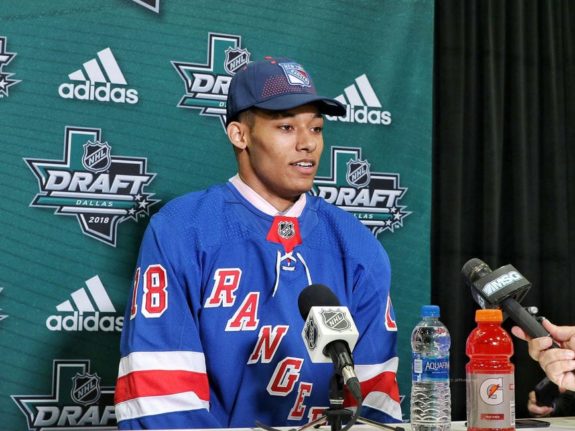As the trade deadline inches closer, the New York Rangers find themselves in a similar position to the one they were in two seasons ago. The Blueshirts are falling out of the playoff race, just as they did in 2017-18. This is an opportunity for the team to make trades and acquire valuable future assets.
The franchise became a seller at the deadline in 2017-18. It was almost a given that veteran players nearing the end their contracts would be traded. One of those players was Rick Nash. Now, two seasons later, trading Nash is paying off for New York.
Rick Nash Trade
Nash was 33 years old that season and while his scoring was down, he was still an excellent defensive forward. While he hadn’t produced more than 40 points in his previous two seasons, he still consistently contributed offensively. He had transitioned from a star player to a role player. He had 23 goals in 67 games during the 2016-17 season and had 18 goals in 60 games with the Blueshirts in 2017-18.

Many teams were interested in acquiring the winger at the deadline, hoping he would help them make a run in the playoffs, and that he would re-sign with them after the season. Jeff Gorton, the general manger of the Rangers, decided to trade Nash to the Boston Bruins in exchange for Boston’s 2018 first-round pick, forwards Ryan Spooner and Matt Beleskey, blueline prospect Ryan Lindgren and a 2019 seventh-round pick.
Rick Nash
Things did not go as planned for Boston after the deadline. Nash, who had a history of concussions, suffered another one shortly after making his debut with the Bruins. He had three goals and three assists in his first 11 games after the trade, but missed the final 12 games of the regular season after suffering the concussion.

Nash returned in the postseason but was quiet offensively. He had three goals and two assists in 12 postseason games and was a minus-seven. In the second round of the postseason, the Bruins won their first game over the Tampa Bay Lightning, but were eliminated after losing the next four games. Nash had no goals and one assist in those four games. Following the season, he did not sign with any team, and was forced to retire because of unresolved issues from the concussion he had suffered with the Bruins.
Ryan Spooner and Ryan Strome
Spooner was the only player acquired by the Rangers who was playing in the NHL at the time of the trade. He immediately made his presence felt with the Blueshirts, tallying 16 points in 20 games after the trade in the 2017-18 season. Despite his promising end to the season, he got off to a dreadful start in 2018-19, and had just two points in 16 games. Gorton decided to trade Spooner to the Edmonton Oilers in exchange for Ryan Strome, who had just two points in 18 games.

Strome showed grit defensively and chipped in offensively following the trade. He scored 18 goals and added 15 assists in 63 games with the Rangers in 2018-19 and established himself as the team’s second center, behind Mika Zibanejad. This season Strome has centered a line with Artemi Panarin and Jesper Fast. He has 43 points in 48 games, which puts him on pace to shatter his career-high of 50 points, which he achieved in 2014-15.
While Strome turned his career around following the trade last season, Spooner failed to do the same. Last season he was briefly sent to the American Hockey League, and he is now out of the NHL. He currently plays for HC Dinamo Minsk in the KHL.
Getting Spooner and swapping him for Strome was an excellent move by Gorton. It has already paid off for the Rangers.
Ryan Lindgren
Lindgren was originally a second-round pick for the Bruins in 2016. He was known as a defensive defenseman, who wasn’t a great skater at the time of the trade. He had a strong season in the AHL for the Hartford Wolf Pack and made his NHL debut with the Rangers last season.

During the offseason, Lindgren lost weight and focused on improving his skating. He earned a promotion from Hartford early in the season and has remained in the lineup for the Blueshirts since then. He has been physical and strong defensively, while still managing to chip in offensively. He has one goal, eight assists and is plus-six in 38 games this season. He hits, blocks shots, and has excelled in killing penalties. At just 21 years old, Lindgren’s future with the Rangers looks very bright.
First Round Pick in 2018
The Rangers traded the first-round pick they had acquired from Boston (the 26th overall pick) as well as a second-round pick they had acquired from the New Jersey Devils to move up in the draft. They then selected K’Andre Miller with the 22nd pick in the draft. Miller began playing hockey as a forward but converted to a defenseman well before he was selected in the draft. His combination of strength and speed led many analysts to compare him to Chris Kreider physically.
Miller is in his second season at the University of Wisconsin–Madison. He has scored 11 goals and added 23 assists in 48 games over his two seasons with the Badgers. He was also an alternate captain for the United States in the 2020 IIHF World Junior Championship.

While Miller is not yet ready to play in the NHL, his physical traits give him the potential to become a star. He has already shown flashes of that potential at Wisconsin, and the Rangers hope he will become a big part of their future.
Matt Beleskey and the 2019 Seventh-Round Pick
The Blueshirts ended up trading away the 2019 seventh-round pick they acquired in the Nash trade, but were unable to move Beleskey, who is now in the final season of a five-year, $19 million contract. Beleskey has spent almost all of his time since the trade playing for the Hartford Wolf Pack, though he has played five games with the Rangers. Once his contract expires at the end of this season, the team can use the cap space to sign other players in the offseason.
For the Rangers
This trade was an excellent one for the Rangers. They weren’t going to make the playoffs anyway in 2017-18, so losing Nash didn’t hurt them. The only difficult part of the trade was having Beleskey’s contract count against the team’s salary cap.
By taking on Beleskey’s contract, the Rangers were able to acquire valuable assets including Spooner, whom they swapped for Strome. Strome is on pace for more than 70 points this season. Lindgren is already an effective NHL defenseman and at just 21 years old can continue to improve. The Blueshirts also have Miller, who may have the highest potential of anyone acquired in the deal. The trade has already been a very good one for the Rangers, and it will be even better if Miller can become the star defenseman the team hopes he will.
As the trade deadline approaches this season, the Rangers will likely be sellers. If so, they can hope to make a similar deal, acquiring young prospects and picks, who can develop into great players for the Blueshirts.